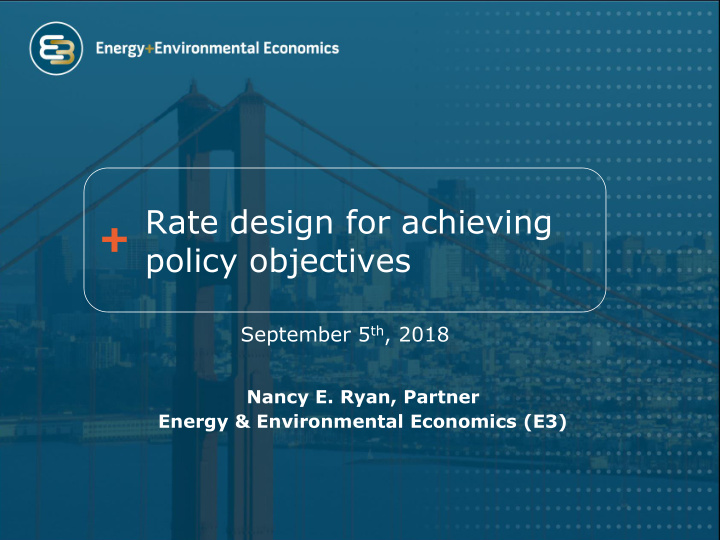



Rate design for achieving policy objectives September 5 th , 2018 Nancy E. Ryan, Partner Energy & Environmental Economics (E3)
Agenda Rate design objectives • Enabling desired policy outcomes consistent with fundamental rate design principles Examples of rate design to achieve policy goals • BC Hydro inclining block structure • NY smart home pilot/Full value tariff • Rate design for electric vehicles (SDG&E) • Using rates to implement Title 24 Community Solar Option Importance of getting rate design right • SGIP program evaluation • NY NEM transition tariff
RATE DESIGN OBJECTIVES
Rate Design: Principles and Practice Guiding Principles per Prof. Bonbright • Customer acceptability • Efficiency • Fairness • Sufficiency Rates can be designed consistent with these principles to meet policy objectives http://www.synapse-energy.com/sites/default/files/Ratemaking-Fundamentals-FactSheet.pdf
E3 INSIGHTS THROUGH RATE DESIGN WORK
Inclining block structures to encourage conservation Flat versus Tiered Rates Monthly Consumption with Flat and Tiered Rates Tiered rates help incentivize conservation Call out With tiered pricing, customers see increase in retail rate after first ‘block’ E3 has worked with clients to determine rate structures and design that will help enable conservation among rate classes • Inclining block tiered rates are effective in giving customers signals for conservation Inclining block tiered rates can also make DSM more cost-effective by reducing payback periods on investments Tiered rate structures for customers can help boost the cost- effectiveness of CCA DSM programs
Full Value Tariff to incentivize an efficient mix of Distributed Resources ‘Layer Cake’ Pricing ‘Uber’ Pricing ‘Subscription’ Pricing E3 worked for developing the ‘Full Value Tariff’ as a part of the NY REV initiative • Rate design options try to balance: Policy Objectives, Rate Impacts, Market Impacts, Recovery of Embedded Costs, Accurate Signals of System Conditions to Customers CCAs can use rate design to ensure that policy objectives are met while ensuring cost recovery and minimizing disruption to customers
Dynamic rate structure to promote beneficial transportation electrification SDG&E Dynamic Vehicle Grid Integration Rate • Goal: shift EV charging to peak solar generation hours and relieve local grid congestion, and share grid benefits with EV drivers • Hourly component based upon CAISO day ahead prices, • Local component reflects grid conditions in WHAT GEOGRAPHIC UNIT • Currently being piloted San Diego area at 350 workplaces and MUDs Opportunity for CCAs to accommodate PV while promoting EV adoption https://www.sdge.com/residential/electric-vehicles/power-your-drive/power-your-drive-ev-drivers
Title 24’s new Community Solar Option can be implemented via rates California Energy Commission Title 24 Solar Rooftop mandate has an alternative compliance pathway for community solar CCA could propose their community solar program to the CEC to become qualified under Title 24 rules if it meets certain criteria: • Criteria designed to achieve equivalence to rooftop solar (permanent, non- transferrable, additional, solar) E3 supported T24 at the CEC and has identified a few ways for CCAs to implement community solar CCAs could make their community solar projects qualify through rates https://www.sdge.com/residential/electric-vehicles/power-your-drive/power-your-drive-ev-drivers
IMPORTANCE OF APPROPRIATE RATE DESIGN
Poor rate design can lead to outcomes that are not societally optimal Customer Bill Savings Average Non-Residential CO2 Emissions by Rate Group and PBI/Non PBI Per SGIP Rebated Capacity CPUC’s SGIP program encourages adoption of Advanced Energy Storage Customers realize bill savings, but GHGs mostly increase TOU pricing provides inadequate signal to optimize storage dispatch against grid costs
NY NEM Transition Tariff for Community Solar (CDG) Too Complicated? “ The methodology is so complicated that consumers will never understand it, putting an end to [community solar] adoption by the mass market, and the inability to predict the value with any certainty will keep the investment community from wanting anything to do with financing projects ,” Robb Jetty, founder of Renovus Solar. As part of the Reforming the Energy Vision Initiative New York State is transitioning away from conventional NEM NYPSC set Phase One Value of Distributed Energy (VDER) compensation regime and set timeline for the transition CDG providers receive compensation based upon a “Value Stack Mass market component of CDG projects get fixed, declining MTC • Uncommitted portion and C&I customers exposed to more variable elements • (capacity and
Thank You Nancy Ryan Kiran Chawla Sandy Hull
Recommend
More recommend